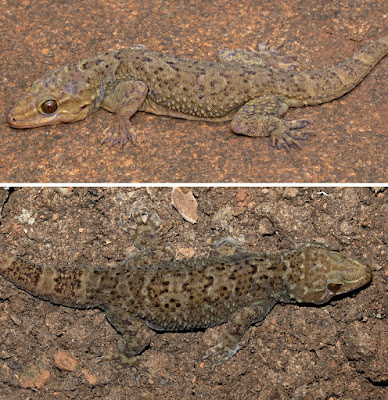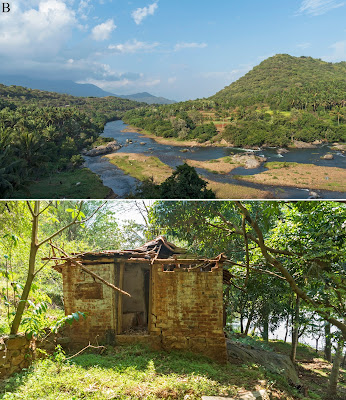Abstract
A new large (94–107mm SVL) species of gecko of the genus Hemidactylus is described from the drier parts of the Western Ghats of India. The new species is closely related to H. graniticolus, from which it can be distinguished based on dorsal pholidosis at mid-body, the structure of tubercles on the dorsum, dorsal pholidosis on the tail. The new species is also 6.6–7.2% divergent from H. graniticolus in the ND2 mitochondrial gene.
Keywords: Gecko, Kerala, morphology, ND2, new species, phylogeny, taxonomy
 |
| Hemidactylus easai sp. nov. showing colour in life, A. Holotype ZSI/WGRC/IR.V/3471, B. Paratype ZSI/WGRC/IR.V/3472. |
Hemidactylus easai sp. nov.
Diagnosis: A large-sized gecko of the genus Hemidactylus, snout-vent length up to SVL 107 mm (n=4). Dorsal pholidosis heterogeneous, composed of roughly circular, granular scales intermixed with much enlarged, fairly regularly arranged longitudinal rows of 17 or 18 striated subtrihedral tubercles at midbody (Fig. 5A-C). Enlarged tubercles on the two most medial parasagittal rows are small, subconical, strongly keeled and rounded, gradually increasing in size and becoming conical towards flanks, last two to three rows on flanks smaller, conical. Two well-developed pairs of postmentals, the inner pair longer than the outer pair and mental, and in broad contact behind the mental. 20–23 tubercles in paravertebral rows; ventrolateral folds distinct; 41 or 42 transverse ventral scale rows at mid-body. Digits with enlarged scansors, lamellae in straight transverse series; 2–5 undivided basal lamellae beneath first finger and 2–5 beneath first toe; 0 or 1 undivided basal lamellae beneath fourth toe; 10–12 lamellae (including undivided and divided) beneath first finger and 10 or 11 beneath first toe; 11–13 lamellae (including undivided and divided) beneath fourth finger and 13 beneath fourth toe; males with series of 24–30 femoral pores on each side separated by 2–4 pore-less scales. Original tail depressed, oval in transverse section with a median dorsal furrow; scales on the tail slightly larger than dorsals, striated, with longitudinal series of 6–8 large, keeled, striated, posteriorly pointed tubercles. Dorsal coloration dull-brown with a series of four or five transverse pale saddles from occiput to sacrum, tail with distinct alternating light and dark bands.
Etymology: The specific epithet is a patronym honouring Dr P. S. Easa, former director of Kerala Forest Research Institute, Thrissur, Kerala for his contributions towards wildlife research, conservation and management, primarily in the Western Ghats over the last four decades and for mentoring SD. We suggest Easa’s rock gecko as common name.
Distribution and natural history notes
Hemidactylus easai sp. nov. is currently known only from the type locality in the Kerala parts of the Western Ghats. The type series was collected from human settlements, inside buildings on the banks of the river Bhavani, which originates from the Nilgiri Hills of Western Ghats (Fig. 8), flows very close to Silent Valley National Park and joins the Cauvery River near Tamil Nadu. The locality is a rain shadow area dominated by dry zone vegetation interspersed with riparian vegetation. The mean annual rainfall in Palakkad district is 2135 mm (Prasad et al. 2021). The holotype and the paratypes were found at night, actively foraging for insects. Several uncollected individuals of H. easai sp. nov. were observed in human settlements and rock crevices in the vicinity of the type locality. Hemidactylus easai sp. nov. was found in sympatry with Cnemaspis gracilis in the same microhabitat and, H. cf. whitakeri and Cyrtodactylus sp. was also found in the type locality.
The type locality of H. easai sp. nov. is in a close proximity to the Silent Valley National Park (SVNP) but not under any legal protection. It is however possible that the new species is found within the SVNP and adjacent Nilgiris mountain range, given that the habitat is contiguous.
Sandeep Das, Saunak Pal, Sasidharan Siddharth, Muhamed Jafer Palot, Veerappan Deepak and Surya Narayanan. 2022. A New Species of Large-bodied Hemidactylus Goldfuss, 1820 (Squamata: Gekkonidae) from the Western Ghats of India. Vertebrate Zoology. 72: 81-94. DOI: 10.3897/vz.72.e76046




